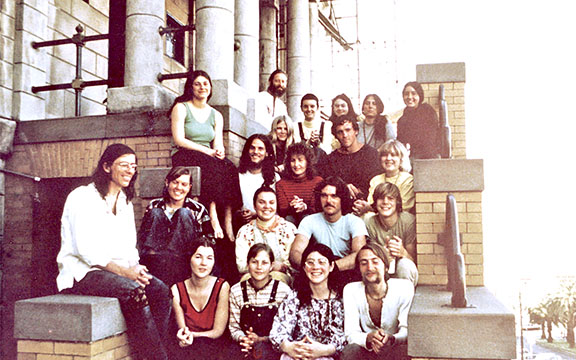
(Photo: Residents at the SFIYI in the early 1970s.)
The year 2020 marks the 50th anniversary of the San Francisco Integral Yoga Institute (IYI). It is also a time to remember and honor all the IYIs that were founded and flourished in California in those early days, and all the pioneers, devotees and students that made it all possible. It was a time of discovery and adventure. A new way of seeing, thinking, living and being were revealed to us. Life took on new meaning as we came together to participate in something bigger than ourselves.

(Photo: Santa Cruz IY health food store.)
During this period, IYIs were established in Berkeley, Santa Cruz, Los Angeles and San Diego. The first ashram was established in Lake County and later, there was one in Santa Barbara. Natural food stores were opened in San Francisco, Santa Cruz, Los Angeles, and Calistoga. We had a natural foods restaurant in Santa Cruz and in Santa Barbara, a Falafel Stand and a food distribution business, called Prana Produce.
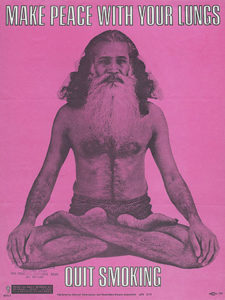
(Photo: San Francisco Tuberculosis & Health Assoc. Ad)
The San Francisco IYI played a unique role in the cultural revolution that was occurring. The early beginnings of the New Age Movement in the late 1960s and 70s that swept the country and later the world can be traced to the San Francisco Bay Area. The San Francisco IYI was well positioned to serve as a womb for this rebirth of spirituality. Many of the great teachers from the East that were drawn to the West by the sincere seeking of the youth made that one of their early stops as they launched their own organizations. Through the IYIs’ outreach programs, Yoga found its way throughout the city, across the Bay, north to Marin, and down the peninsula. Classes were taught in schools, colleges, and hospitals; at the San Francisco Chronicle newspaper, the YWCA, the Sierra Club, and the SF jail; for the Department of Social Services and the Lighthouse for the Blind, and at many other venues.
The IYI joined with members of about a dozen other spiritual organizations in the area, including: 3HO, the Sivananda Yoga Center, the Sufi Order, and Ananda Ashram to found “Meeting of the Ways,” a pioneer in interfaith dialogue and activities. We had monthly meetings, our own radio show, and held a grand annual event, providing a forum for the founders and Gurus of our respective groups, and an opportunity for us to celebrate together, as we shared from the richness of our varied traditions.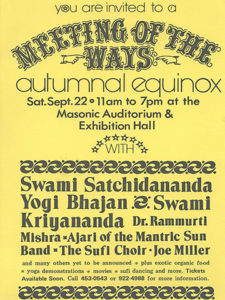
Through it all, the San Francisco IYI became sacred ground. There was always a special fragrance inside. The very building glowed; passersby were magnetically drawn up those many steps to inquire within and their lives were transformed. Many people spent their formative years as a monastic in that center.
We were very strong in our sadhana (spiritual practice) and service. We awoke early, meditated from 4:30 – 6:00 am, did Hatha Yoga together, and conducted classes throughout the day till 9 pm, when we came together for our evening meditation. The IYI was open all day, every day, to welcome students and visitors.
It was so much fun just living and doing Yoga together. Those were magical times and unusual occurrences became the norm. What follows are some stories from around the state that will give a glimpse of what life was like back then.
We didn’t take ourselves quite so seriously. At the San Francisco IYI, people began falling asleep in morning meditation. So, we came up with a novel solution: we purchased a large water gun. One person was assigned each morning to watch and spray anyone who began to nod off. The problem was quickly resolved.
Mice had taken up residence upstairs in our temple. Late one evening, I felt like meditating. I sat down, wrapped a blanket around me, and settled into the stillness. Suddenly, there was a bustling sound under the altar. With half-opened eyes, I saw a little form scurry out and slip under my blanket. The peace was so strong, I just closed my eyes and continued meditating. Two hours later, as I arose to leave, the mouse fell out of my blanket and ran back under the altar. We had shared a lovely meditation together.
The next day, Swami Divyananda posted a notice outside our back door: “Position available for good mouser.” In less than twenty-four hours, as if in response to the ad, a cat showed up and filled the position.
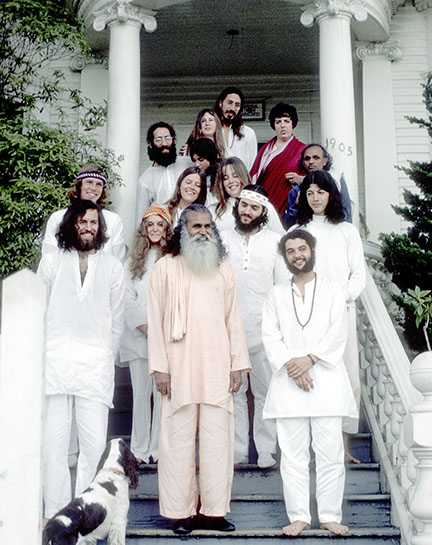
(Photo: Swami Satchidananda & members of the Berkeley IYI, 1969. The author is just behind Sri Swamiji.)
Today, we often end programs with a talk on “How to Bring the Teachings into Daily Life.” Back then, we didn’t have to talk about it; we just naturally did it. About a mile from the Berkeley IYI, there was a really good ice cream store. When we wanted a treat, we would form a line and wend our way through the streets in a walking meditation. Invariably, when we arrived at our destination, the line was longer, as others had playfully and meditatively joined us along the way.
One day, an elderly woman showed up at the San Francisco IYI with several cartons of books by Sri Swami Sivanandaji. She had visited his ashram in India. Many were rare, some were first editions, and there were even some that were autographed by him. Somehow, she was inspired to donate them to us. There was one problem: the binding on many of the books was broken. We weren’t quite sure what to do with them, because if we put them on our bookshelves, they would soon fall apart.
A couple of days later, a salesman rang our doorbell. No salesperson had ever come to the door before, nor did any come after. Not only that, he climbed all those steps toting a large and ungainly case. He was selling, of all things, a portable book-binding machine! He asked if we had any books that needed binding, and I told him, “As a matter of fact, we do.” He then gave us a demonstration of how the machine worked and asked if we’d be interested in purchasing it. I told him it was much too expensive for us to consider that, and other than the books in these cartons, we really had no need for it.
And then he offered to leave the machine with us for a week to try it out. I told him again that we wouldn’t be purchasing it. He said, “That’s okay, just bind the books that need it, and I’ll pick it up in a week. He proceeded to remove from his briefcase sheets of blue vinyl to use for the covers. When I offered to pay him for the materials, he even refused that. He just said, “Bind your books, and I’ll be back.”
We made a schedule, rotated shifts, and had someone binding books non-stop till he returned a week later. We finished just as he arrived. He simply asked if we had bound all the books. I said, “Yes.” He said, “Good.” And then he took the machine and left. We never heard from again. We never received any literature from his company in the mail. I’m not sure if a company even existed! Knowing how much Swami Sivanandaji loved to give, his attention to detail, and how thorough he was in his service, it seemed that he wasn’t simply satisfied in giving us all those books. He made sure they were in top condition, too! It was a lesson about the true spirit of service and how to do it properly. It seemed like an affirmation that the life we were leading, however imperfectly, was sufficient to draw the divine grace. Our good intentions and heartfelt efforts were deemed worthy in the sight of that Higher Power.
I know that people who did not meet Swami Satchidananda (Sri Gurudev) have sometimes felt regret, or a sense of loss, at having missed him while he walked among us. In the early 1970s, he met with a small group of us at our ashram in northern California. We were the “pioneers,” the founders of the first ashram. He told us that we were like fertilizer for the soil. The real crop he had come for was not even born yet. Our generation was laying the foundation and preparing the way. On several occasions in the year before his passing, he told us that when he passes, he will be even more accessible to all who seek his guidance and support. Many people have experienced that feeling of connection.
Sri Gurudev usually visited California in the winter. They were times to reset and recharge, and learn lessons about spiritual life. On one occasion, he playfully remarked: “On the East Coast I’m mining diamonds and on the West Coast I’m mining gold.” It was a beautiful image, but the deeper significance of his words became clear later.
Sri Gurudev’s main residence was on the East Coast. Coal is mined in that part of the country, and diamonds are formed when coal is subjected to constant pressure over a long time. Sri Gurudev’s constant presence, watchful eye, and close involvement with the ashram constituted the subtle pressure needed to effect spiritual transformation.
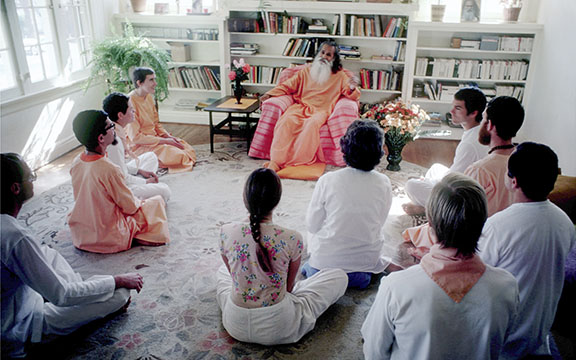
(Photo: Los Angeles IYI, mid-1970s)
In California, it was different. We did not see him on a daily basis, nor nearly as much. The time may have been shorter by chronological measure, but the intensity and activity were so concentrated, that it felt like days were packed into minutes and years were packed into months. We were like gold being purified—heated to the boiling point. As we cooled, layer after layer of impurities were eliminated. When he left, it was in the crucible of our practice—our sadhana and service—that the impurities were released and the transformative process occurred.
Probably the high point each year for the California devotees was our annual retreat. Every morning and evening, Sri Gurudev would come and share the ancient wisdom with us and our lives were forever transformed. Several hundred people would typically attend the early retreats that were held at Camp Kennolyn in the Santa Cruz Mountains. We came from many places for diverse reasons, but together, we plunged into five days of intensive practice. No matter what our intention in coming, we left filled with the prospect of new possibilities.
I remember one such retreat well. One afternoon, around 3:00 p.m., we had a walking meditation. The leader set out with over a hundred people in single file behind him. Several hours passed, and the staff gathered in the dining hall for dinner, only to find it totally empty. This was serious, because no matter what else someone might skip, no one missed meals.

(Photo: Santa Cruz retreat)
It was dusk; darkness was quickly descending. We began to compare notes about when we had last seen anyone, and then, before our startled gaze, the retreatants began trickling in, still silent and in single file. They had been lost in the Santa Cruz Mountains for three hours. They marched in peacefully, just as if everything had transpired according to plan. It was beautiful to behold and, in a way, conveys the spirit of those early days in California.
One of the greatest teaching moments I ever experienced occurred during a retreat in Santa Barbara. I was serving as the coordinator, and my mind was overly busy, filled with a so many details requiring attention.
It didn’t occur during a lecture or a class; I simply had to hand Sri Gurudev a piece of paper with information. My mind was jumping all over, already planning its next task. As I leaned forward to give him the paper, he gently, consciously extended his hand to receive it, totally focused on that particular interaction. At that moment, it seemed like I was all that existed for him and receiving that paper was all that mattered. The incessant whirling of my mind stopped; for an instant, everything stood still. I experienced perfect peace. I understood the power of “Now” and being in the moment, the gift of being totally present for someone, and the grace that flows from focused attention.

(Photo: Swami Karunananda with her Guru in Santa Barbara.)
One year, we received news that Sri Gurudev would not be able to attend our retreat. We were disappointed and shaken. We thought that Gurudev had something special that we lacked, and when we were with him, he gave some of “it” to us. We depended on that to recharge our batteries for the coming year. So, it was with some uncertainty that we decided to conduct the retreat anyway. We observed silence and maintained the same schedule. We came together for meditation, conducted Hatha Yoga classes, and senior members gave discourses on the Yoga teachings. And much to our surprise, we got “it,” even though Sri Gurudev wasn’t physically present. It was a dramatic demonstration of the key teaching of Yoga: that what we seek is who we are in truth. To experience that, we need to calm the mind and go within—not look for someone else to give it to us. We learned firsthand the power of the teachings and the purpose of sangha.
On another occasion, Sri Gurudev came to San Francisco for his Jayanthi (birthday celebration). In the morning at the Institute, we had a beautiful puja in honor of his Jayanthi. In the evening, we enjoyed a wonderful program of offerings at a lovely auditorium in the city. We knew it would be the right place for the event when we learned the seating capacity was 770! The grand finale was an extraordinary slide show in honor of Sri Gurudev’s life and service. It was so inspiring that, at its conclusion, the entire audience jumped to their feet in a standing ovation. This spirit of devotion and jubilation continued as we proceeded to an Indian restaurant for a late-night banquet.
By the time we had finished the meal, it was nearly two in the morning. Sri Gurudev entered an elevator and then playfully began inviting others to join him. There was a sign posted that read: “Maximum capacity 12 people; do not exceed.” With an air of mischief, he gathered about 30 of us into that tiny conveyance. When we were crammed in close, he reached forward and pushed the button. The door closed, the elevator started to move, and then with a sudden lurch, stopped between floors.
So, there we were in the wee hours of a Sunday morning, trapped in an elevator together. There were devotees on the floors above and below us, chanting and praying. Others began calling all over the city trying to locate a repairman. At this point, I had the thought: “We don’t know how long we may be in here. The most important thing is to conserve oxygen. We should all be as still as possible.” As if in response to my thought, Gurudev immediately said we should all start chanting Rama, Rama—which is a powerful mantra that kindles the inner fire. So, not only would be using up the physical oxygen, but on a subtle level, we would be creating a lot of heat, too.
As the minutes passed, people began responding in different ways. Some repeatedly tried pushing the buttons. One person tried to climb out the top of the compartment. Some were calm; others panicked. After about forty minutes, Sri Gurudev reached over and pressed the button. The elevator immediately proceeded to the ground level, and we all took a deep, grateful breath as we left the building.
On the way back to the Institute, we asked Gurudev to explain the strange order of events that had occurred. He replied that God had wanted to make a test and when all the information was in, the test was over. It was not necessary for it to continue one moment longer. There are two lessons that could be drawn from this experience that may be relevant to our current global situation: 1) When faced with challenging circumstances, know that the moment the karma is purged, the situation will change. 2) There is always a Higher Plan behind all that unfolds. Have faith in a positive outcome.
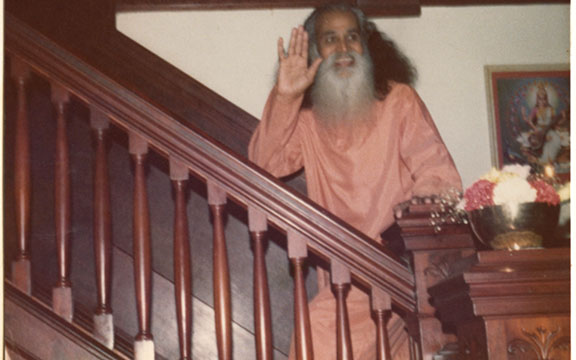
(Photo: After the celebration, Swami Satchidananda returns to the IYI.)
It was around 5 am when we finally got back to the IYI. We were both exhausted and excited over the day’s events. We gathered together with Sri Gurudev in the living room. It was so still. Normally, the residents and staff would be bustling around during his visit, attending to details and hosting guests. Now, there was no one at the door, no phone calls to answer, nothing to do. So, we all sat there together, after a long day of service, enfolded in his peace. Then, suddenly, softly, he began to sing to us Tamil lullabies. After a while, settled and sleepy, we all retired to our rooms, to rest for adventures to come.
Many fund-raising luncheons were organized to raise money for the building of the Light Of Truth Universal Shrine (LOTUS). One was held at a church in Santa Monica, California. The food was being brought from an Indian restaurant in downtown Los Angeles. There were seventy people registered to attend, but about one hundred twenty-five showed up. And when the food arrived, there was only enough for about fifty people. The entire serving crew panicked. I remember us staring blankly into one another’s eyes unable to move. What were we to do? We couldn’t possibly feed all the guests who had come.
Right about then, we heard Sri Gurudev calling from inside the dining hall: “Where are you? What’s happening? Come out. People are waiting. Just come with whatever you have.” So, with some trepidation, we emerged, bringing what little food we had. Gurudev asked us to line up in front of the head table for the recitation of the meal prayer. After the prayer, he looked at us and said: “Don’t think; just serve.” We went from table to table and, miraculously, everyone was served. We all breathed a sigh of relief and slipped quietly away into the back room.
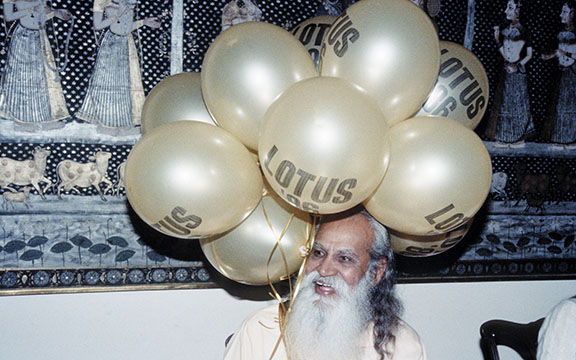
(Photo: LOTUS fundraising luncheon)
But then Gurudev called us again and said, “They are still hungry; we need to serve seconds.” Don’t think; just serve.” And we did., and then thirds. Anything anyone wanted was there. The person who had organized the event was so busy taking care of various details that she didn’t have time to eat. At the very end, she said she just wished she could have had some dessert, as it was her favorite. I looked up, and there on a tray was one remaining dessert. Afterward, when it was time to clean up, we had more food left over than originally had come. We took it back to the Los Angeles IYI where it fed people the following week. It was the yogic version of the “miracle of the loaves and fishes.”
There were two lessons that could be gleaned from this experience: 1) When there is faith and when it is expressed through loving service, even the impossible becomes doable. As the Holy Bible says: “If you have faith the size of a mustard seed, you can say to the mountain ‘come hither’ and it will come, and nothing will be impossible to you.” 2) When called upon to do some meaningful service, don’t let the mind’s doubts or excuses hold you back. Have faith that all you need will be provided at the right time.
There is a story from the life of St. Teresa of Avila that describes how Jesus appeared to her and told her to open a new monastery a great distance away from the convent where she was living. So, the next morning, she dressed quickly, put on her cloak, and was about to embark. One of the sisters stopped her by the door and asked if she had everything she needed for the journey; did she have enough money? St. Teresa reached into her small purse and took out the equivalent of five dollars. The other nun asked her: “How do you expect to travel so far, obtain a building, properly outfit it for a monastery, and then make the return trip with only five dollars? St. Teresa thought a moment and replied: “You are right: Teresa and five dollars can do nothing. But God, Teresa, and five dollars can do anything.” She went and it was all accomplished.
As it was in past times, so it is today: faith draws grace. That grace is magnified and made manifest when directed toward loving service. Then, life takes on new meaning and all things are possible. That spirit made the early days in California an unforgettable and cherished period in IYI history, the era of “California Gold.”
About the Author:
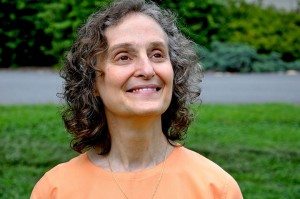 Swami Karunananda is a senior disciple of Sri Swami Satchidananda. In 1975, she was ordained as a monk into the Holy Order of Sannyas. She has had almost 50 years experience teaching all aspects of Yoga and specializes now in workshops, retreats, and teacher training programs that focus on the science of meditation, the philosophy of Yoga, personal transformation, and Yoga breathing techniques for better health and well-being. She developed, and for 30 years has taught, the Integral Yoga Teacher Training programs in Raja Yoga and in Meditation.
Swami Karunananda is a senior disciple of Sri Swami Satchidananda. In 1975, she was ordained as a monk into the Holy Order of Sannyas. She has had almost 50 years experience teaching all aspects of Yoga and specializes now in workshops, retreats, and teacher training programs that focus on the science of meditation, the philosophy of Yoga, personal transformation, and Yoga breathing techniques for better health and well-being. She developed, and for 30 years has taught, the Integral Yoga Teacher Training programs in Raja Yoga and in Meditation.
Swami Karunananda served as president of Satchidananda Ashram–Yogaville in Virginia and in California, as well as director of the Integral Yoga Institutes in San Francisco and in Santa Barbara. She currently serves on the Board of Trustees, and as the chairperson of the Spiritual Life Board at Satchidananda Ashram–Yogaville, Virginia.
Interested in fostering interfaith understanding and harmony, she is featured in the interfaith documentary entitled, “With One Voice.” She also compiled and edited the Lotus Prayer Book, a collection of prayers from various faith traditions, and Enlightening Tales as told by Sri Swami Satchidananda. She served as contributing editor for The Breath of Life: Integral Yoga Pranayama, as well as a senior writer for the Integral Yoga Magazine. In her book, Awakening: Aspiration to Realization Through Integral Yoga, she describes the spiritual path and provides guidance for the journey.


